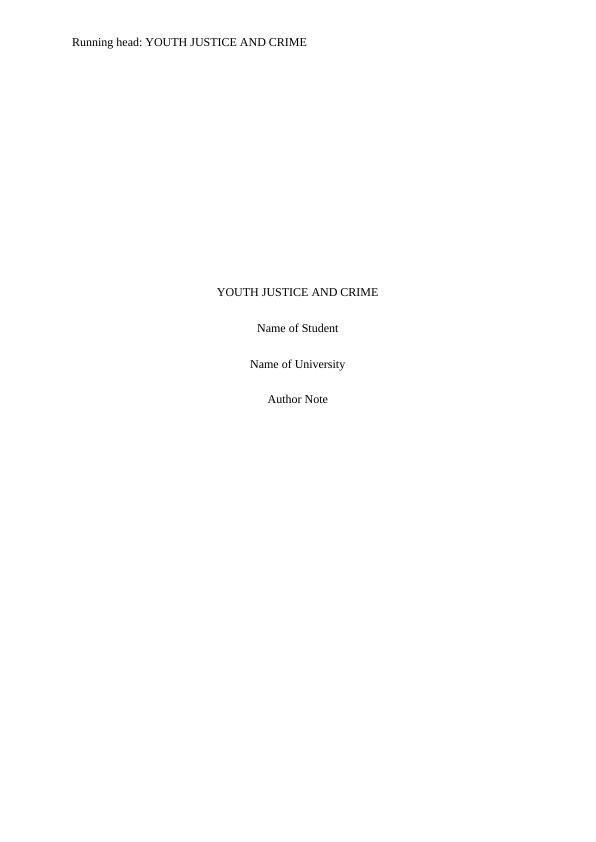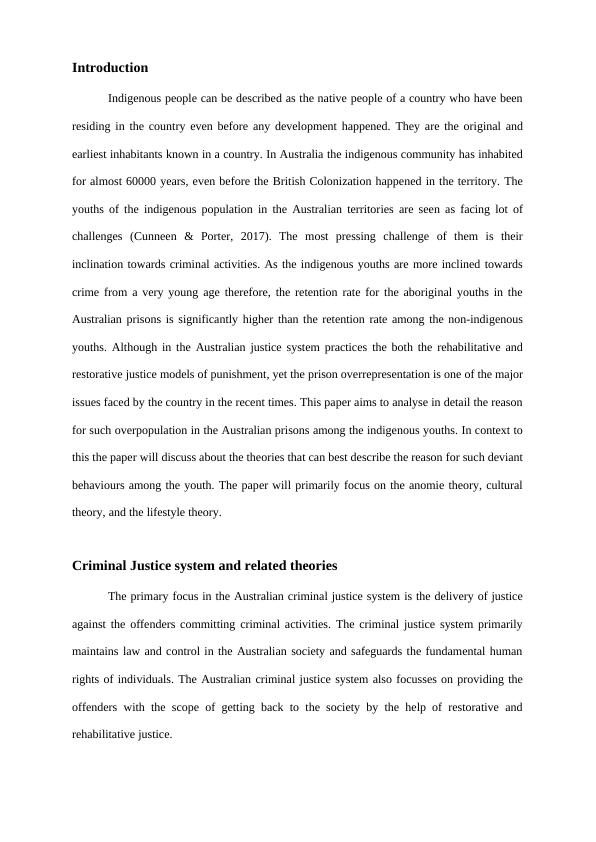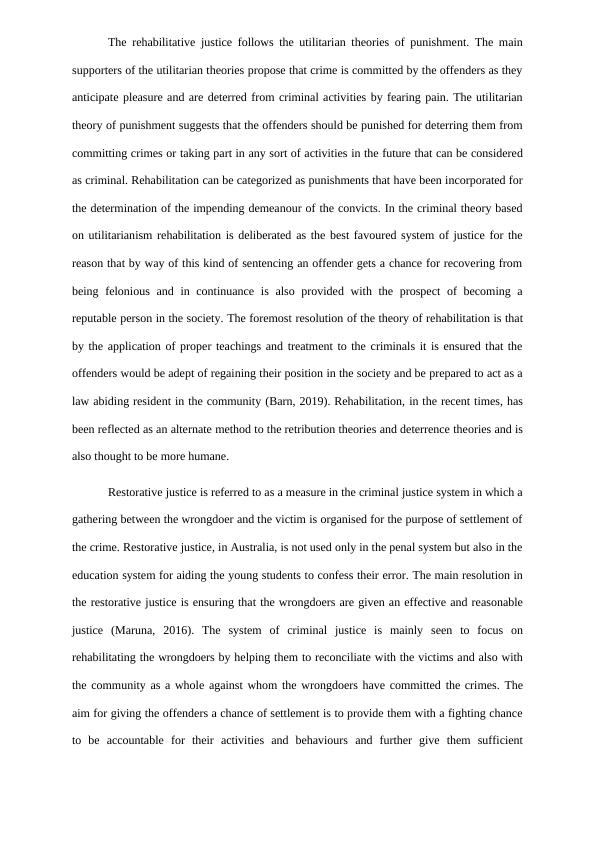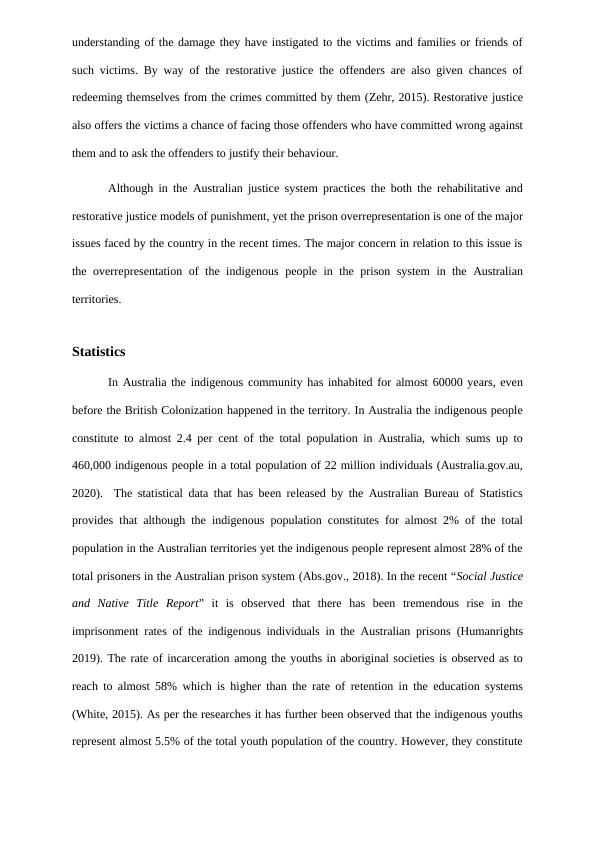Youth Justice and Crime | System and Theories
Added on 2022-08-25
11 Pages3271 Words24 Views
Running head: YOUTH JUSTICE AND CRIME
YOUTH JUSTICE AND CRIME
Name of Student
Name of University
Author Note
YOUTH JUSTICE AND CRIME
Name of Student
Name of University
Author Note

Introduction
Indigenous people can be described as the native people of a country who have been
residing in the country even before any development happened. They are the original and
earliest inhabitants known in a country. In Australia the indigenous community has inhabited
for almost 60000 years, even before the British Colonization happened in the territory. The
youths of the indigenous population in the Australian territories are seen as facing lot of
challenges (Cunneen & Porter, 2017). The most pressing challenge of them is their
inclination towards criminal activities. As the indigenous youths are more inclined towards
crime from a very young age therefore, the retention rate for the aboriginal youths in the
Australian prisons is significantly higher than the retention rate among the non-indigenous
youths. Although in the Australian justice system practices the both the rehabilitative and
restorative justice models of punishment, yet the prison overrepresentation is one of the major
issues faced by the country in the recent times. This paper aims to analyse in detail the reason
for such overpopulation in the Australian prisons among the indigenous youths. In context to
this the paper will discuss about the theories that can best describe the reason for such deviant
behaviours among the youth. The paper will primarily focus on the anomie theory, cultural
theory, and the lifestyle theory.
Criminal Justice system and related theories
The primary focus in the Australian criminal justice system is the delivery of justice
against the offenders committing criminal activities. The criminal justice system primarily
maintains law and control in the Australian society and safeguards the fundamental human
rights of individuals. The Australian criminal justice system also focusses on providing the
offenders with the scope of getting back to the society by the help of restorative and
rehabilitative justice.
Indigenous people can be described as the native people of a country who have been
residing in the country even before any development happened. They are the original and
earliest inhabitants known in a country. In Australia the indigenous community has inhabited
for almost 60000 years, even before the British Colonization happened in the territory. The
youths of the indigenous population in the Australian territories are seen as facing lot of
challenges (Cunneen & Porter, 2017). The most pressing challenge of them is their
inclination towards criminal activities. As the indigenous youths are more inclined towards
crime from a very young age therefore, the retention rate for the aboriginal youths in the
Australian prisons is significantly higher than the retention rate among the non-indigenous
youths. Although in the Australian justice system practices the both the rehabilitative and
restorative justice models of punishment, yet the prison overrepresentation is one of the major
issues faced by the country in the recent times. This paper aims to analyse in detail the reason
for such overpopulation in the Australian prisons among the indigenous youths. In context to
this the paper will discuss about the theories that can best describe the reason for such deviant
behaviours among the youth. The paper will primarily focus on the anomie theory, cultural
theory, and the lifestyle theory.
Criminal Justice system and related theories
The primary focus in the Australian criminal justice system is the delivery of justice
against the offenders committing criminal activities. The criminal justice system primarily
maintains law and control in the Australian society and safeguards the fundamental human
rights of individuals. The Australian criminal justice system also focusses on providing the
offenders with the scope of getting back to the society by the help of restorative and
rehabilitative justice.

The rehabilitative justice follows the utilitarian theories of punishment. The main
supporters of the utilitarian theories propose that crime is committed by the offenders as they
anticipate pleasure and are deterred from criminal activities by fearing pain. The utilitarian
theory of punishment suggests that the offenders should be punished for deterring them from
committing crimes or taking part in any sort of activities in the future that can be considered
as criminal. Rehabilitation can be categorized as punishments that have been incorporated for
the determination of the impending demeanour of the convicts. In the criminal theory based
on utilitarianism rehabilitation is deliberated as the best favoured system of justice for the
reason that by way of this kind of sentencing an offender gets a chance for recovering from
being felonious and in continuance is also provided with the prospect of becoming a
reputable person in the society. The foremost resolution of the theory of rehabilitation is that
by the application of proper teachings and treatment to the criminals it is ensured that the
offenders would be adept of regaining their position in the society and be prepared to act as a
law abiding resident in the community (Barn, 2019). Rehabilitation, in the recent times, has
been reflected as an alternate method to the retribution theories and deterrence theories and is
also thought to be more humane.
Restorative justice is referred to as a measure in the criminal justice system in which a
gathering between the wrongdoer and the victim is organised for the purpose of settlement of
the crime. Restorative justice, in Australia, is not used only in the penal system but also in the
education system for aiding the young students to confess their error. The main resolution in
the restorative justice is ensuring that the wrongdoers are given an effective and reasonable
justice (Maruna, 2016). The system of criminal justice is mainly seen to focus on
rehabilitating the wrongdoers by helping them to reconciliate with the victims and also with
the community as a whole against whom the wrongdoers have committed the crimes. The
aim for giving the offenders a chance of settlement is to provide them with a fighting chance
to be accountable for their activities and behaviours and further give them sufficient
supporters of the utilitarian theories propose that crime is committed by the offenders as they
anticipate pleasure and are deterred from criminal activities by fearing pain. The utilitarian
theory of punishment suggests that the offenders should be punished for deterring them from
committing crimes or taking part in any sort of activities in the future that can be considered
as criminal. Rehabilitation can be categorized as punishments that have been incorporated for
the determination of the impending demeanour of the convicts. In the criminal theory based
on utilitarianism rehabilitation is deliberated as the best favoured system of justice for the
reason that by way of this kind of sentencing an offender gets a chance for recovering from
being felonious and in continuance is also provided with the prospect of becoming a
reputable person in the society. The foremost resolution of the theory of rehabilitation is that
by the application of proper teachings and treatment to the criminals it is ensured that the
offenders would be adept of regaining their position in the society and be prepared to act as a
law abiding resident in the community (Barn, 2019). Rehabilitation, in the recent times, has
been reflected as an alternate method to the retribution theories and deterrence theories and is
also thought to be more humane.
Restorative justice is referred to as a measure in the criminal justice system in which a
gathering between the wrongdoer and the victim is organised for the purpose of settlement of
the crime. Restorative justice, in Australia, is not used only in the penal system but also in the
education system for aiding the young students to confess their error. The main resolution in
the restorative justice is ensuring that the wrongdoers are given an effective and reasonable
justice (Maruna, 2016). The system of criminal justice is mainly seen to focus on
rehabilitating the wrongdoers by helping them to reconciliate with the victims and also with
the community as a whole against whom the wrongdoers have committed the crimes. The
aim for giving the offenders a chance of settlement is to provide them with a fighting chance
to be accountable for their activities and behaviours and further give them sufficient

understanding of the damage they have instigated to the victims and families or friends of
such victims. By way of the restorative justice the offenders are also given chances of
redeeming themselves from the crimes committed by them (Zehr, 2015). Restorative justice
also offers the victims a chance of facing those offenders who have committed wrong against
them and to ask the offenders to justify their behaviour.
Although in the Australian justice system practices the both the rehabilitative and
restorative justice models of punishment, yet the prison overrepresentation is one of the major
issues faced by the country in the recent times. The major concern in relation to this issue is
the overrepresentation of the indigenous people in the prison system in the Australian
territories.
Statistics
In Australia the indigenous community has inhabited for almost 60000 years, even
before the British Colonization happened in the territory. In Australia the indigenous people
constitute to almost 2.4 per cent of the total population in Australia, which sums up to
460,000 indigenous people in a total population of 22 million individuals (Australia.gov.au,
2020). The statistical data that has been released by the Australian Bureau of Statistics
provides that although the indigenous population constitutes for almost 2% of the total
population in the Australian territories yet the indigenous people represent almost 28% of the
total prisoners in the Australian prison system (Abs.gov., 2018). In the recent “Social Justice
and Native Title Report” it is observed that there has been tremendous rise in the
imprisonment rates of the indigenous individuals in the Australian prisons (Humanrights
2019). The rate of incarceration among the youths in aboriginal societies is observed as to
reach to almost 58% which is higher than the rate of retention in the education systems
(White, 2015). As per the researches it has further been observed that the indigenous youths
represent almost 5.5% of the total youth population of the country. However, they constitute
such victims. By way of the restorative justice the offenders are also given chances of
redeeming themselves from the crimes committed by them (Zehr, 2015). Restorative justice
also offers the victims a chance of facing those offenders who have committed wrong against
them and to ask the offenders to justify their behaviour.
Although in the Australian justice system practices the both the rehabilitative and
restorative justice models of punishment, yet the prison overrepresentation is one of the major
issues faced by the country in the recent times. The major concern in relation to this issue is
the overrepresentation of the indigenous people in the prison system in the Australian
territories.
Statistics
In Australia the indigenous community has inhabited for almost 60000 years, even
before the British Colonization happened in the territory. In Australia the indigenous people
constitute to almost 2.4 per cent of the total population in Australia, which sums up to
460,000 indigenous people in a total population of 22 million individuals (Australia.gov.au,
2020). The statistical data that has been released by the Australian Bureau of Statistics
provides that although the indigenous population constitutes for almost 2% of the total
population in the Australian territories yet the indigenous people represent almost 28% of the
total prisoners in the Australian prison system (Abs.gov., 2018). In the recent “Social Justice
and Native Title Report” it is observed that there has been tremendous rise in the
imprisonment rates of the indigenous individuals in the Australian prisons (Humanrights
2019). The rate of incarceration among the youths in aboriginal societies is observed as to
reach to almost 58% which is higher than the rate of retention in the education systems
(White, 2015). As per the researches it has further been observed that the indigenous youths
represent almost 5.5% of the total youth population of the country. However, they constitute

End of preview
Want to access all the pages? Upload your documents or become a member.
Related Documents
Five Philosophies of Punishment Practiced in Criminal Justice Systemlg...
|5
|1093
|629
Criminal Justice Assignment 2022lg...
|6
|1425
|18
Report on Theories of Punishmentlg...
|8
|1265
|200
Allocating Resources Among Prisons and Social Programs in the Battle Against Crimelg...
|5
|1857
|218
Effect of Imprisonment on Young Delinquentslg...
|10
|2428
|346
Justice, Punishment and Rehabilitation in the UK Criminal Justice Systemlg...
|11
|4103
|349